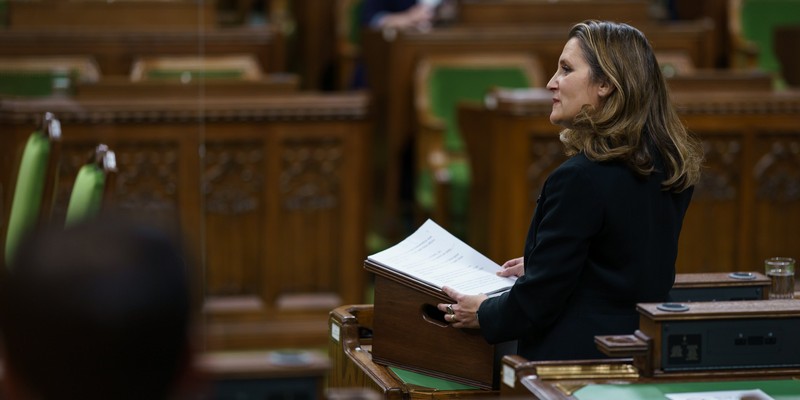Trudeau government can’t bank on low interest rates forever

Finance Minister Chrystia Freeland recently stated the obvious—that she has “no crystal ball” to determine when interest rates will rise. Indeed, governments can’t control interest rates nor guarantee they will stay low for long. The Trudeau government has used historically low interest rates to justify hundreds of billions of dollars in program spending and $1.2 trillion in projected net debt (2020/21), so it’s critical to understand the risk higher rates pose to federal finances.
Federal debt interest costs are projected to hit $20.2 billion in 2020/21 and jump to $34.3 billion by 2025/26. In sum, interest payments on federal debt will cost Canadian taxpayers more than $150 billion during this period (that’s money that could have been spent on key priorities including health care). And these projections assume interest rates remain at historically low levels.
But of course, like Minister Freeland said, there’s no guarantee interest rates will remain low. In fact, experts warn that rates could rise over the next few years. In reality, Ottawa cannot continue to significantly increase spending (under the pretense that interest rates will remain low forever) without raising tax rates. Back in June, Fitch credit rating agency downgraded Canadian debt to reflect our deteriorating government finances. This downgrade indicates higher risk and thus higher relative interest rates in the future. And remember, this was before hundreds of billions of dollars in new and planned federal spending.
Moreover, through its own actions, the Trudeau government seems to expect interest rates to rise. In its fall economic update, the government said it will pursue a “historic” increase in long-term bonds in an effort to lock-in historically low rates. In other words, the government will issue more long-term bonds under the rationale that interest rates are at risk of rising.
But despite the government’s long-term bonds strategy, short-term treasury bills and bonds comprise a vast majority of government debt issued in 2019/20 and 2020/21. TD’s economic forecast projects interest rates on these short-term securities to rise no later than 2022. By 2025, two- and five-year bond yields are forecast to more than quadruple while three-month treasury bills are expected to be eight times their current rate. (Notably, long-term bond yields are also expected to increase.)
Clearly, there’s a risk of higher interest rates in coming years. While we cannot know exactly how interest rates will change, here are some potential consequences of increases.
As interest rates rise, all else equal, government debt interest costs also rise. If, for example, the effective interest rate on government debt rose by one percentage point, annual interest costs on federal debt would jump from $20.3 billion to $32.6 billion by 2021/22, an increase of $12.3 billion. By 2025/26, using the government’s current forecast, a one percentage point increase in the effective rate would increase annual interest costs from $34.3 billion to $48.1 billion, an increase of $13.8 billion.
Higher debt interest costs, all else equal, help produce higher deficits, which risk further downgrades in Canada’s debt rating and an increased risk premium attached to our debt. This can result in a vicious cycle of larger and larger budget deficits and more debt accumulation, like during the 1990s debt crisis when interest costs on federal debt consumed one out of every three dollars of government revenue.
The federal government faces many daunting fiscal challenges. The risk of higher interest rates—which would further erode federal finances—must be taken seriously.


